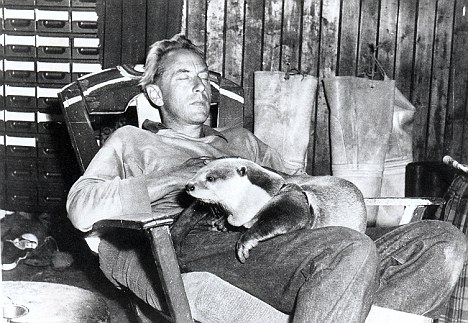GAVIN MAXWELL died on this date, (b: 1914) I don’t know about you, but I have always loved otters and that love first made itself known to me in the book Ring of Bright Water by Gavin Maxwell. So it was with great delight that I discovered that this book was written by a gay man.
A Scottish naturalist and author, best known for his work with otters Gavin Maxwell wrote the wonderful book Ring of Bright Water in 1960 about how he brought an otter back from Iraq and raised it in Scotland. Ring of Bright Water sold more than a million copies and was made into a movie starring Bill Travers and Virginia McKenna in 1969. The title Ring of Bright Water was taken from a poem by Kathleen Raine, who said in her autobiography that Maxwell had been the love of her life.
Maxwell’s book Ring of Bright Water describes how, in 1956, he brought a Smooth-coated otter back from Iraq and raised it in “Camusfearna” (Sandaig) on the west coast of Scotland. He took the otter, called Mijbil, to the London Zoological Society, where it was decided that this was a previously unknown sub-species of Smooth-coated Otter. It was therefore named Lutrogale perspicillata maxwelli (or, colloquially, “Maxwell’s Otter”) after him. It is thought to have become extinct in the alluvial salt marshes of Iraq as a result of the large-scale drainage of the area that started in the 1960s.
In his book The Marsh Arabs, Wilfred Thesiger wrote:
[I]n 1956, Gavin Maxwell, who wished to write a book about the Marshes, came with me to Iraq, and I took him round in my tarada for seven weeks. He had always wanted an otter as a pet, and at last I found him a baby European otter which unfortunately died after a week, towards the end of his visit. He was in Basra preparing to go home when I managed to obtain another, which I sent to him. This, very dark in colour and about six weeks old, proved to be a new species. Gavin took it to England, and the species was named after him.
The otter became woven into the fabric of Maxwell’s life. Kathleen Raines’ relationship with Maxwell ended in 1956 when she indirectly caused the death of Mijbil. Raine held herself responsible not only for losing Mijbil but for a curse she had uttered shortly beforehand, frustrated by Maxwell’s homosexuality: “Let Gavin suffer in this place as I am suffering now.” Raine blamed herself thereafter for all Maxwell’s misfortunes, beginning with Mijbil’s death and ending with the cancer that took his life in 1969
Maxwell was the youngest son of Lieutenant-Colonel Aymer Maxwell and Lady Mary Percy, fifth daughter of the seventh Duke of Northumberland. His paternal grandfather, Sir Herbert Maxwell, was an archaeologist, politician and natural historian. Maxwell was raised in the tiny village of Elrig, in south-western Scotland. Maxwell’s relatives still reside in the area and the family’s ancient estate and grounds are in nearby Monreith.
During World War II, Maxwell served as an instructor with the Special Operations Executive. After the war, he purchased the Isle of Soay of Skye in the inner Hebrides, Scotland. According to his book Harpoon at a Venture (1952, since republished under various titles), bad planning and a lack of finance meant his attempt to establish a basking shark fishery there between 1945-48 proved unsuccessful.
In 1956, Maxwell toured the reed marshes of Southern Iraq with explorer Wilfred Thesiger. Maxwell’s account of their trip appears in A Reed Shaken By The Wind, later published under the title People of the Reeds. It was hailed by the New York Times reviewer as “near perfect”.
Maxwell next moved to Sandaig (which he called Camusfeàrna in his books), a small community opposite Eileen Iarmain on a remote part of the Scottish mainland. This is where his “otter books” are set. After Ring of Bright Water (1960), he wrote The Rocks Remain (1963), in which the otters Edal, Teko, Mossy and Monday show great differences in personality. The Rocks Remain is a sequel to Ring of Bright Water, as it demonstrates the difficulty Maxwell was having, possibly as a result of his mental state, in remaining focused on one project and the impact that had on his otters, Sandaig, and his own life.
In 1966, he traveled to Morocco with a male companion, tracing the dramatic lives of the last rulers of Morocco under the French. His account of the trip was published as Lords of the Atlas: The Rise and Fall of the House of Glaoua 1893-1956. During the Moroccan Years of Lead, the regime there considered his book subversive and banned its importation.
In The House of Elrig (1965), Maxwell describes his family history and his passion for the calf-country, Galloway, where he was born. It was during this period that he met ornithologist Peter Scott and the young Terry Nutkin, who later became a children’s television presenter. A closeted homosexual, Maxwell married Lavinia Renton (née Lascelles) on February 1 1962. The marriage lasted little more than a year and they divorced in 1964.
In 1968, Maxwell’s Sandaig home was destroyed by fire and he moved to the lighthouse cottage of Eilean Bàn (White Island), another island he owned off the coast of Skye. He invited John Lister-Kaye to join him on Eilean Bàn and help him build a zoo on the island and work on a book about British wild mammals. Lister-Kaye accepted the invitation, but both projects were abandoned when Maxwell died from cancer later that same year.
